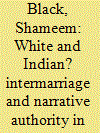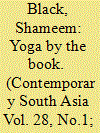| Srl | Item |
| 1 |
ID:
191699


|
|
|
|
|
| Summary/Abstract |
This essay investigates competing visibilities within a cultural practice that India has promoted as a privileged image of national identity: yoga. These competing perceptions, in which yoga can be seen as at once iconically and yet not uniquely Indian, pose a challenge for the Indian state in its management of yoga’s symbolic value. Analysing rhetoric from India’s nation-branding pursuits in the context of Western popular culture, I argue that the state manipulates visual regimes of yoga in ways that turn this spectre of Indian invisibility into a testament to Indian ubiquity. Invisibility as a problem is thus transformed into invisibility as a privilege, revealing how the potential fluidity across two different regimes of identity and power can render state fantasies more resilient.
|
|
|
|
|
|
|
|
|
|
|
|
|
|
|
|
| 2 |
ID:
120710


|
|
|
|
|
| Publication |
2013.
|
| Summary/Abstract |
How does intermarriage affect a storyteller? In this essay, I seek to examine literary narratives of South Asian family formation that take late twentieth-century intermarriages-particularly between Indian men and white American women-as their central governing trope. This phenomenon raises two linked questions: first, how do South Asian families recruit or reject individuals within constructs of South Asian identity; and second, to what extent do individuals not of South Asian descent gain the authority to imagine and re-imagine the contours of their multiracial family? I here examine the work of the white American writer Robbie Clipper Sethi, whose novel-in-stories, The Bride Wore Red (1996), tells the unfolding saga of a multiracial South Asian family in the United States and India. These narratives of white women socialised into ambivalent places within larger South Asian families, I argue, figure larger anxieties about imaginative representation across the mobile borders of what is considered one's culture. The family structure emerges as a contradictory space that empowers this border-crossing representational authority by simultaneously calling this authority into question.
|
|
|
|
|
|
|
|
|
|
|
|
|
|
|
|
| 3 |
ID:
171862


|
|
|
|
|
| Summary/Abstract |
This essay analyses the cultural politics of yoga through a literary history of its twentieth- and twenty-first-century connection to books. The midcentury instruction manual for postural yoga, exemplified by B.K.S. Iyengar’s Light on Yoga, created a postcolonial literary genre that aimed to resolve particular tensions within the structure of Indian identity in a globalizing world. This genre has influenced the rise of twenty-first-century yoga fiction in Western popular culture in English. Ironically, such fiction also works against ideals of globalized Indianness projected through Iyengar’s manual. Through this exploration of yoga in print culture, this essay argues that the cultural instruction performed through writing is not just about yoga, but part and parcel of yoga itself.
|
|
|
|
|
|
|
|
|
|
|
|
|
|
|
|